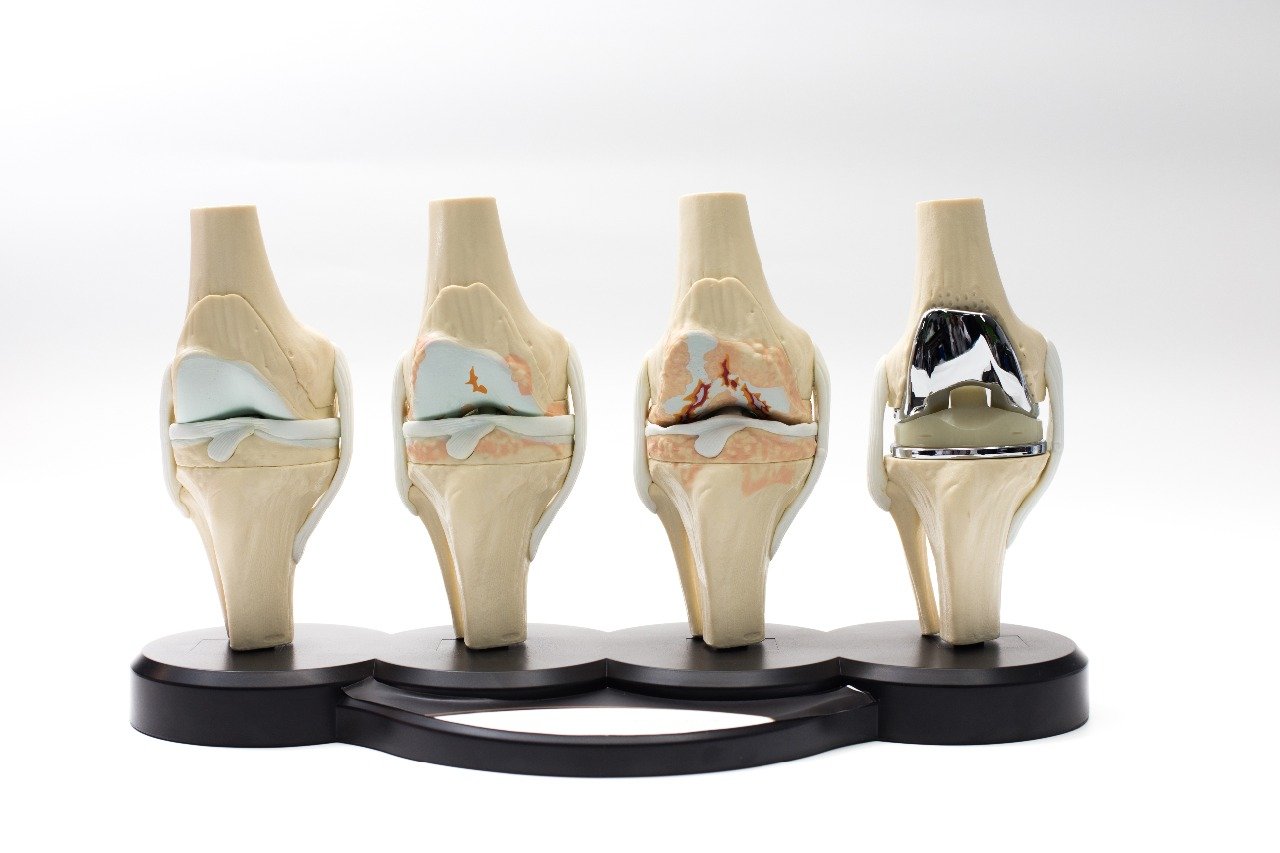
Knee Prosthesis Surgery
Knee replacement surgery can help relieve pain and restore function in severely affected knees. A knee joint replacement removes damaged bone and cartilage from the joint and replaces the prosthesis with special metal alloys and other components. The aim of knee joint replacement surgery is to provide a pain-free range of motion in the knee joint, ensuring the highest quality of daily life.
Who Should Have Knee Replacement?
For the knees, exercise, medications, physiotherapy methods are applied in patients with pain and deformity, but the pain in the knees does not disappear, activities such as walking, climbing stairs in daily life are strictly limited and it is understood that the articular cartilage is severely damaged. Preferably, prosthesis is recommended if the patient is over 65 years of age. In some rheumatic diseases, such as rheumatoid arthritis, prosthesis can be performed at an earlier age.
Which Diseases Can Knee Replacement Cause?
For various reasons, degeneration (calcification) of the knee joint occurs. Calcification of the knee joint is called gonarthrosis (knee calcification). Most gonarthrosis occurs spontaneously with age. Excess weight increases degeneration. Degeneration of the knee joint can be caused by tears, injuries and operations of the meniscus, rheumatologic diseases, infectious diseases, traumatic cartilage lesions. The knee replacement operation is performed in all patients with serious diseases of the knee joint. In the presence of an active infection in the knee joint, knee replacement is not performed.
What are the Stages of Knee Replacement Treatment?
Firstly, knee replacement should be at a stage where it is beneficial for patients who have not used non-prosthetic treatment options (medicine, physiotherapy, etc.). Everything can be seen well on the knee X-ray. After the operation is solved, anesthesia is prepared. Before the operation, the presence of tooth decay, wounds or any other infection in the body should be carefully examined and if so, it is very important to treat it. The operation can be performed under local anesthesia or general anesthesia. The duration of the operation varies depending on the patient, but it takes about 1 hour. The next day, the patient can take care of personal needs with a crutch.
What are the Risks of Knee Replacement Surgery?
There are early and late knee replacement surgery risks during surgical treatment. There are risks associated with anesthesia present in every operation. In addition, there may be temporary or permanent blood vessel and nerve injuries in the area during handling in the surgical field.
Infection is the most important early and late postoperative complication. . This is the most important complication affecting the survival of the prosthesis. This can be easily prevented by paying attention to the foci of infection before surgery and by careful care of the wound. Another late complication is loosening of the prosthesis. To prevent loosening, it is important that the patient loses weight and exercises the knee regularly.
How is Knee Replacement Surgery Performed?
During knee surgery, the damaged parts of the knee bones are removed and metal and plastic implants are attached to the knee surface in the appropriate direction. . We can list the procedures performed during the knee surgery operation as follows:
- A small cannula is placed in your hand or arm. . This cannula is used to give you antibiotics and other medicines during the operation.
- After the painkiller has started to take effect, your knee will be sterilized with a special solution.
- The process of resurfacing the knee joint usually takes 1 hour.
- The implants are attached to the bones. The ligaments surrounding the knee need to be adjusted to ensure optimal knee function.
- First, temporary prostheses are applied. If deemed appropriate, the actual prostheses are inserted.
- If the surgeon is satisfied with the fit and function of the implants, the incision is closed.
- A special tube (drain) is inserted into the wound to remove natural fluids from the body.
- A sterile dressing is applied. An elastic bandage is wrapped from the foot to the groin.
- The effects of the anesthesia begin to wear off while you are in your recovery room and you regain consciousness.
- Your knee is tender for a few days.
You will be under the supervision of a doctor and nurse during all these knee replacement surgery procedures.
The structure of the knee joint is complex compared to other joints. The range of motion of the joint, which consists of three main bones: patella, femur and tibia, is quite wide. These bones are protected by cartilage tissue. Both the deterioration of blood flow in the joint or inflammatory diseases involving the knee joint and problems such as calcification cause the cartilage tissue in the knee joint to wear out and deteriorate its structure. The most definitive and permanent treatment for this problem, which progresses over time, is knee replacement surgery.
Knee replacement surgeryIt is the cleaning of the calcified area in the knee joint and the removal of worn bones and the placement of a prosthesis made of special materials. Knee prosthesis surgery is generally applied to patients with advanced calcification problems, severe deformation of the knee joint and other treatment methods are not beneficial.
Knee replacement surgery, which is a surgical intervention depending on the preference of patients in advanced ages where medication, physical therapy and injection applications do not provide improvement, is an application that lasts approximately 1 hour under general anesthesia.
For a successful knee replacement surgery;
- Doctor selection and surgery planning
- Surgery process
- Care is of great importance in the postoperative recovery process.
How is Knee Replacement Surgery Performed?
In recent years, the increase in the number of studies in the field of medicine and the development of technology; knee replacement surgeries provide a very comfortable process for both the doctor and the patient. The type and size of the prosthesis, which is decided during the knee replacement surgery planning, is placed in the patient's knee joint during surgery. In knee replacement surgery performed with the open surgery technique, the inflamed tissues in the joint are first cleaned. After the knee prosthesis is inserted into the joint; the application area is closed in such a way as to cause minimal cosmetic problems.
The choice of the doctor who will perform knee replacement surgery is one of the most important factors affecting the success of the surgery. For this reason, an experienced and specialized surgeon should be consulted before surgery.
After Knee Replacement Surgery
Knee replacement surgery There are some important points that patients should pay attention to. These can be listed as follows;
- In case of any infection, a doctor should be consulted.
- Dental checks and treatments should not be interrupted.
- Living spaces should be free of factors that may pose a risk of falling. Items such as coffee tables and carpets should be positioned so as not to pose a risk of falling.
- Heavy sports should be avoided.
- Long walks, climbs and jumps that strain the knee joints should be avoided.
- Knee joints need to be protected from trauma such as falls, bumps and accidents.
- Bone and muscle health needs to be protected. The diet should be designed to strengthen bone health.
- Exercise programs recommended by the doctor should not be interrupted.
Knee replacement surgery The patient's quality of life will improve afterwards. Problems such as pain sensation and limitation of movement will disappear. For this reason, the things to be considered after surgery should not be ignored.
After prosthesis is applied to the knee joints through surgical intervention, the knee joints should be protected from traumas and strains. In addition, attention should be paid to the nutrition program in order to protect joint and bone health and especially to consume foods that strengthen the bones. In order to control pain and prevent edema formation after surgery, it is necessary to use the medications recommended by the doctor, not to interrupt exercise programs and not to interrupt physical therapy and rehabilitation sessions. At the same time, it is of great importance to protect the whole body from inflammation and infections in order not to prevent the prosthesis used during surgery from fusing with the joint.
What are the Ways to Prevent Infection after Knee Replacement Surgery?
Knee replacement surgery Afterwards, the doctor makes many recommendations that should and should not be followed. The implementation of these recommendations is of great importance for both shortening the healing process and prolonging the life of the prosthesis. The biggest risk factor after knee replacement surgery is infections. Exposure of any part of the body to infection causes serious damage to the knee prosthesis. Ways to prevent infection can be listed as follows;
- Dental checks should not be neglected before surgery and any infection must be treated.
- Attention should be paid to hand and foot hygiene.
- Care should be taken for nail care.
- Eye examinations should not be neglected.
Can I Have an MRI After Knee Replacement Surgery?
After knee replacement surgeryThere are many question marks in the minds of patients. The most important of these questions is whether there is any application that can damage the prosthesis placed in the knee joint. Knee replacement surgery Before having an MRI afterwards, the doctor must be aware that the prosthesis has been applied before. In fact, MR technology can cause serious damage to the prosthesis.
Rehabilitation After Knee Replacement Surgery
After knee replacement surgery, the knee joints lose their strength to a certain extent. At the same time, a certain period of time is needed for the implanted prosthesis to fuse with the bone tissue. For this reason, especially in the postoperative period; physical therapy and rehabilitation applications are carried out in order for the patient to regain mobility and get rid of the feeling of pain. In this process, the patient should eat healthy, maintain their ideal weight, avoid heavy sports and reverse movements, and protect the surgical site from traumatic events such as bumps, falls or blows.


Contact
We are at your service 24/7
Error: Contact form not found.
Patient Satisfaction
Beautiful thoughts from all of you
If you're looking for car insurance, we will help you to find the You bring emendous value to company. We have generated more leads in the last

Farhan Smith Health Mentor
If you're looking for car insurance, we will help you to find the You bring emendous value to company. We have generated more leads in the last

Elwin Dawson Medical Specialist
If you're looking for car insurance, we will help you to find the You bring emendous value to company. We have generated more leads in the last

Poral Dawson Home Nurse
If you're looking for car insurance, we will help you to find the You bring emendous value to company. We have generated more leads in the last


